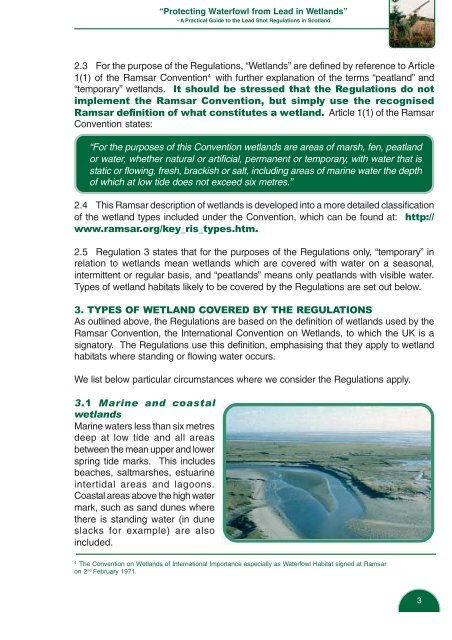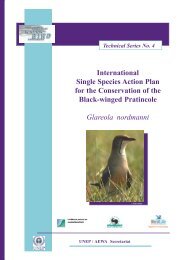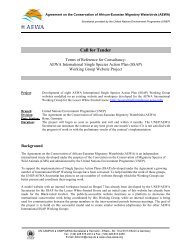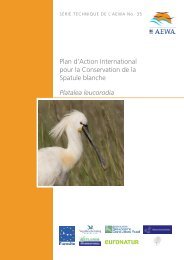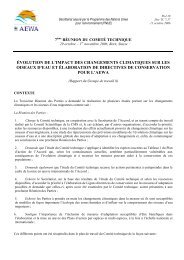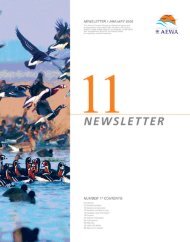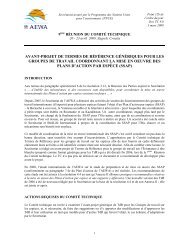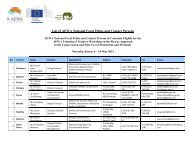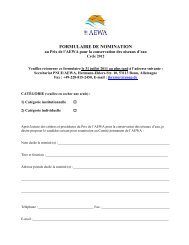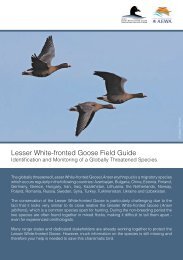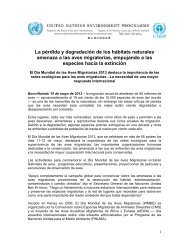"Protecting Waterfowl from Lead in Wetlands" - A practical - AEWA
"Protecting Waterfowl from Lead in Wetlands" - A practical - AEWA
"Protecting Waterfowl from Lead in Wetlands" - A practical - AEWA
You also want an ePaper? Increase the reach of your titles
YUMPU automatically turns print PDFs into web optimized ePapers that Google loves.
“<strong>Protect<strong>in</strong>g</strong> <strong>Waterfowl</strong> <strong>from</strong> <strong>Lead</strong> <strong>in</strong> Wetlands”<br />
- A Practical Guide to the <strong>Lead</strong> Shot Regulations <strong>in</strong> Scotland<br />
2.3 For the purpose of the Regulations, “Wetlands” are def<strong>in</strong>ed by reference to Article<br />
1(1) of the Ramsar Convention 4 with further explanation of the terms “peatland” and<br />
“temporary” wetlands. It should be stressed that the Regulations do not<br />
implement the Ramsar Convention, but simply use the recognised<br />
Ramsar def<strong>in</strong>ition of what constitutes a wetland. Article 1(1) of the Ramsar<br />
Convention states:<br />
“For the purposes of this Convention wetlands are areas of marsh, fen, peatland<br />
or water, whether natural or artificial, permanent or temporary, with water that is<br />
static or flow<strong>in</strong>g, fresh, brackish or salt, <strong>in</strong>clud<strong>in</strong>g areas of mar<strong>in</strong>e water the depth<br />
of which at low tide does not exceed six metres.”<br />
2.4 This Ramsar description of wetlands is developed <strong>in</strong>to a more detailed classification<br />
of the wetland types <strong>in</strong>cluded under the Convention, which can be found at: http://<br />
www.ramsar.org/key_ris_types.htm.<br />
2.5 Regulation 3 states that for the purposes of the Regulations only, “temporary” <strong>in</strong><br />
relation to wetlands mean wetlands which are covered with water on a seasonal,<br />
<strong>in</strong>termittent or regular basis, and “peatlands” means only peatlands with visible water.<br />
Types of wetland habitats likely to be covered by the Regulations are set out below.<br />
3. TYPES OF WETLAND COVERED BY THE REGULATIONS<br />
As outl<strong>in</strong>ed above, the Regulations are based on the def<strong>in</strong>ition of wetlands used by the<br />
Ramsar Convention, the International Convention on Wetlands, to which the UK is a<br />
signatory. The Regulations use this def<strong>in</strong>ition, emphasis<strong>in</strong>g that they apply to wetland<br />
habitats where stand<strong>in</strong>g or flow<strong>in</strong>g water occurs.<br />
We list below particular circumstances where we consider the Regulations apply.<br />
3.1 Mar<strong>in</strong>e and coastal<br />
wetlands<br />
Mar<strong>in</strong>e waters less than six metres<br />
deep at low tide and all areas<br />
between the mean upper and lower<br />
spr<strong>in</strong>g tide marks. This <strong>in</strong>cludes<br />
beaches, saltmarshes, estuar<strong>in</strong>e<br />
<strong>in</strong>tertidal areas and lagoons.<br />
Coastal areas above the high water<br />
mark, such as sand dunes where<br />
there is stand<strong>in</strong>g water (<strong>in</strong> dune<br />
slacks for example) are also<br />
<strong>in</strong>cluded.<br />
4<br />
The Convention on Wetlands of International Importance especially as <strong>Waterfowl</strong> Habitat signed at Ramsar<br />
on 2 nd February 1971.<br />
3


